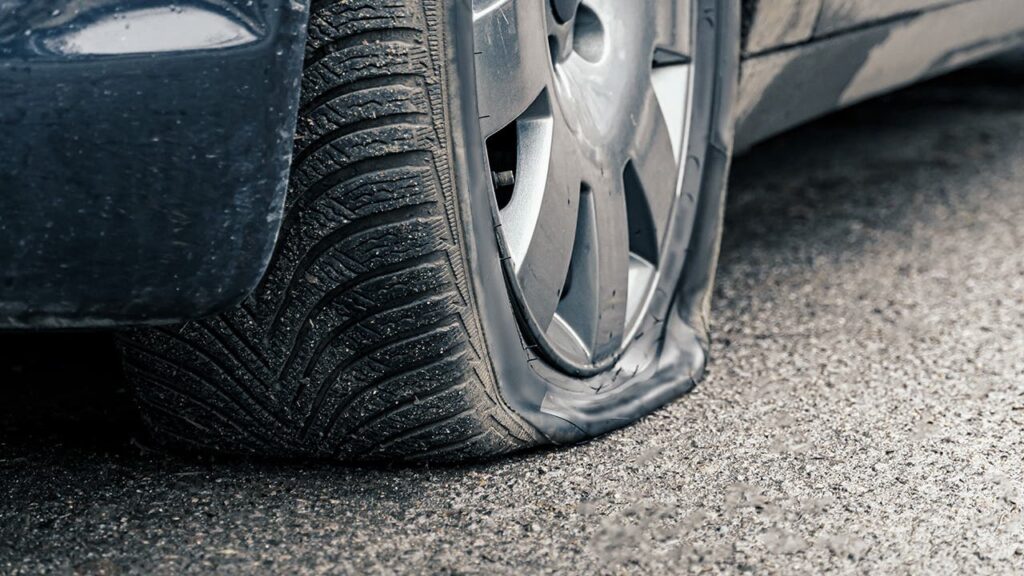Pull over safely to the side of the road and turn on your hazard lights. Stay calm and assess your surroundings.
Getting a flat tire while cruising on the highway can be a daunting experience. It’s crucial to stay composed and prioritize safety. The first step is to steer your vehicle to a secure location on the side of the road, away from traffic.
Once stopped, activating your hazard lights alerts other drivers to your predicament. Whether you’re a seasoned driver or a novice, being prepared for such unexpected events is important. This guide will walk you through the necessary precautions and steps to handle a flat tire, ensuring you can either fix the issue or seek assistance without compromising your safety. By following structured, clear advice, you’ll be back on the road with minimal hassle. Remember, preparation and a calm approach are key to tackling roadside emergencies like a flat tire on the highway.
Signs Of A Flat Tire On A Highway
Driving on a highway demands full attention. A flat tire can happen without warning. Spotting the signs early is crucial for safety. Here’s what to look out for.
Immediate Sensations
- Control feels off: Your vehicle starts to pull to one side.
- Steering gets heavy: Turning the wheel requires more effort.
- Unusual vibrations: The steering wheel or seat shakes.
Audible Indicators
- Loud noises: Thumping sounds come from the affected tire.
- Hissing air: A clear sign air is escaping from the tire.
- Flapping sound: The tire tread may be coming apart.

Initial Steps To Take
Experiencing a flat tire on a highway requires immediate action. These initial steps ensure safety and prepare you for the tire change process. Remain calm to handle the situation effectively.
Reduce Speed Safely
A sudden flat tire needs a cool head and a steady foot. Gently ease off the acceleration. Avoid hitting the brakes hard. A slow deceleration prevents the car from swerving. Watch your dashboard for the optimum speed limit during this maneuver.
Signal And Move To The Shoulder
At a safe speed, activate your turn signal. This indicates to other drivers that you’re moving over. Check your mirrors and over your shoulder to ensure a clear path. Glide the car towards the shoulder, away from traffic. Firm but gentle steering ensures a smooth transition. Once safely parked, turn on your hazard lights to alert others.
With these immediate actions, you’re on the right track to addressing a flat tire. Safety comes first; take a deep breath and prepare for the next steps.
Prioritizing Your Safety
Experiencing a flat tire on a highway can be alarming. Safety must be your top priority.
When your tire goes flat, stay calm. Keep control of your car. Slowly reduce your speed.
Make your safety the main goal. Read on to learn the right steps to stay safe during such events.
Assessing The Traffic Situation
Once you notice a flat tire, first look at the traffic around you.
If the highway is bustling, extra caution is needed.
Scan your mirrors quickly. Look for a gap in the traffic.
Move to the shoulder safely when it’s clear.
Positioning Your Vehicle Appropriately
Find a level spot on the shoulder. Avoid curves in the road where visibility is low.
Turn your wheels away from traffic. This is a precaution in case your vehicle starts rolling.
Using Emergency Signals
Turn on your hazard lights immediately. They alert other drivers that you’re facing trouble. Place warning triangles or flares if you have them.
Place them behind your car to ensure oncoming traffic knows to pass carefully.
If it’s dark, keep your interior light on. It makes your car visible to others.
Changing The Tire
Experiencing a flat tire on a bustling highway can be daunting. But with the right know-how, you’ll be back on the road in no time. This guide outlines the crucial steps for a swift and safe tire change.
Locating Your Spare And Tools
Before anything, identify where your spare tire and necessary tools are stowed. Typically, you’ll find these essentials:
- Spare tire: In the trunk under the mat, or attached beneath the car.
- Lug wrench: To loosen and tighten the lug nuts.
- Jack: To lift the vehicle off the ground.
- Owner’s manual: For specific instructions.
Securing The Vehicle
Once tools are in hand, secure your vehicle to ensure safety:
- Turn on your hazard lights and park away from traffic.
- Apply the parking brake to prevent rolling.
- Use wheel wedges in front or behind the tires for extra stability.
Step-by-step Tire Changing Process
Follow this process to change your tire:
| Step | Action |
|---|---|
| 1 | Remove the hubcap or wheel cover using the flat end of your lug wrench. |
| 2 | Loosen the lug nuts about ½ turn with the wrench. |
| 3 | Place the jack under the vehicle frame near the flat tire. |
| 4 | Jack up the car until the tire is about 6 inches off the ground. |
| 5 | Remove lug nuts and the flat tire. |
| 6 | Mount your spare tire and screw on the lug nuts by hand. |
| 7 | Lower the vehicle and tighten the lug nuts with the wrench. |
| 8 | Replace the hubcap and stow your tools and flat tire. |
Remember, your spare tire is a temporary solution. Drive to a professional to have your tire repaired or replaced as soon as possible.
Alternatives When You Can’t Change The Tire
Picture this: You’re on the highway, and you hear that dreaded thump-thump of a flat tire. You pull over, ready to change it, but there’s a hitch—perhaps you’re missing a spare, or the lug nuts are too tight. Fear not! When changing a tire isn’t an option, other solutions are at hand. Let’s explore what you can do to get back on the road safely and quickly.
Calling For Roadside Assistance
Roadside assistance is your safety net in times of roadside trouble. Many insurance policies and car warranties include this service. Here are simple steps to summon help:
- Find your membership or insurance card.
- Dial the roadside assistance number provided.
- Provide your location and describe the issue.
- Stay inside your vehicle, if safe, until help arrives.
Signaling For Help From Passing Drivers
When roadside assistance isn’t an option, rely on the kindness of fellow drivers. Keep these tips in mind to signal effectively:
- Pop the hood to indicate trouble.
- Use hazard lights or safety triangles to alert others.
- Stay with your car, behind barriers if possible.
- Write ‘HELP’ on paper and display it on windows.
As a last resort, signal other drivers with a friendly wave or gesture to gain attention. However, always prioritize your safety and wellbeing — never attempt to flag down vehicles if it puts you in harm’s way.

Post-flat Tire Protocols
Experiencing a flat tire on a highway can trigger panic. Stay calm. Follow these post-flat tire protocols to get back on the road safely.
Checking Tire Pressure
Once off the highway, assess your tire. Use a tire pressure gauge if available. Properly inflated spare tires are crucial for safe driving. Record the pressure and ensure it aligns with your vehicle’s recommendation, found in the owner’s manual or on the driver’s side door jamb.
Visiting A Mechanic
With your spare tire in place, drive cautiously to a trusted mechanic. Maintaining low speeds is necessary to prevent further damage. A mechanic will determine if your tire needs repair or replacement.
Replacing Your Spare
Don’t delay in getting a new tire after using the spare. Spares are temporary solutions not meant for long distances or high speeds. Prolonged use can lead to wear on other tires or the spare itself. Replace the spare as soon as feasible.

Frequently Asked Questions
How To React To A Highway Flat Tire?
Immediately signal and gently steer your vehicle toward the breakdown lane or shoulder, away from traffic. Turn on your hazard lights to alert other drivers, and slowly decrease speed. Do not brake harshly, as this could cause a loss of control.
What Safety Precautions Should I Take?
Once parked safely, put on a reflective vest if available, and place warning triangles or flares behind your vehicle to alert oncoming traffic. Stay well off the roadway and wait for assistance if it’s not safe to change the tire yourself.
Can I Drive On A Flat Tire?
Driving on a flat tire can cause wheel or vehicle damage. It’s advised to stop driving and replace the flat with a spare tire or call roadside assistance. Only in emergencies, one may drive slowly for a very short distance to reach a safer location.
What Tools Are Needed For A Tire Change?
You’ll need a spare tire, a jack, a lug wrench, and ideally, a wheel wedge. Keep these tools in your vehicle along with your owner’s manual, which provides specific instructions for changing a tire on your particular model.
Conclusion
Dealing with a flat tire on the highway can be daunting. By following these steps, you’ll manage the situation with confidence. Always prioritize personal safety and vehicle visibility. Remember, regular maintenance helps prevent unexpected incidents. Drive safely, and stay prepared for those unexpected road challenges.





















